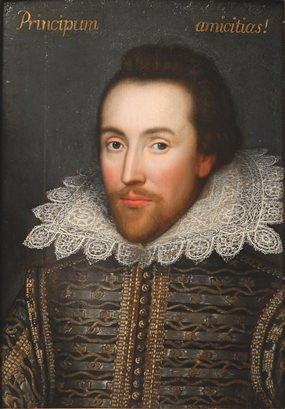Four hundred years ago, on 23rd April 1616, the English actor, poet and playwright William Shakespeare died at his home in the country town of Stratford-upon-Avon. He was fifty-two. We don’t know the reason for his death. In fact, we know precious little about Shakespeare, despite the fact that he’s regarded as the greatest writer in the English language and probably the world’s finest playwright.
We don’t even know exactly what Shakespeare looked like. There’s no contemporary description of his physical appearance and it seems that he never commissioned a portrait. For many years, the only picture was the so-called Chandos portrait, named after the Duke of Chandos who once owned the work. It was painted between 1600 and 1610 and attributed to the artist John Taylor. Then in 2006 the Cobbe portrait came to light, originally attributed to Cornelis Janssen. In 2009, researchers at the Shakespeare Birthplace Trust claimed that the Cobbe portrait (shown here) is almost certainly William Shakespeare and painted from life. Although the strands of evidence seem to suggest that the man in the picture is probably Shakespeare, many experts disagree. Nobody seems to be certain. And if it isn’t Shakespeare, then who is it?
 William Shakespeare. Or is it?
William Shakespeare. Or is it?
Several of Shakespeare’s plays were on the London stage by 1592. During the following years some were published with his name on the title page, suggesting that he had already achieved some fame. After 1594, his work was performed exclusively by a company called The Lord Chamberlain’s Men. With Shakespeare himself as one of the actors, it became the leading company in London and was responsible for building The Globe Theatre in 1599 on the southern bank of the River Thames.
After the death of Queen Elizabeth in 1603, the company was awarded a royal warrant by the newly-crowned King James I and changed its name to The King’s Men. By this time, Shakespeare was at the peak of his career. If he’d written only Hamlet and King Lear, he would probably still be regarded as England’s greatest playwright. But he wrote nearly forty immortal plays and his work has been translated into at least eighty languages including Arabic, Albanian, Yakut, Zulu and even Klingon, the constructed language of TV’s Star Trek. Yes, Thai too, since you asked.
The first Thai translations were made by King Vajiravudh (Rama VI) who was also a prolific dramatist. The King studied at Britain’s Royal Military College at Sandhurst and later at Christ Church College, Oxford. In the early years of the twentieth century he translated three plays into Thai: The Merchant of Venice, As You Like It, and Romeo and Juliet.
It was not until 1623, seven years after Shakespeare’s death, that the complete plays were published thanks to John Heminges and Henry Condell, two of Shakespeare’s friends from The King’s Men. Known as The First Folio, it was a massive publication of nine hundred pages and contained thirty-six plays, almost all of Shakespeare’s dramatic writing. It sold for between fifteen shillings to one pound, worth about £100 or $142 in today’s currency.
Shakespeare had a remarkable insight into human nature and an extraordinary capacity for drama and description. If he couldn’t think of a word that matched his intended meaning, he just made one up. It’s estimated that he invented about three thousand words, many of which are still in common use today. These include accused, addiction, advertising, amazement, arouse and assassination and that’s only a selection beginning with the letter “a”. When audiences saw Hamlet for the first time, they encountered six hundred new words they’d never heard before.
But Shakespeare didn’t limit himself to inventing words. Four hundred years after this death, we still use dozens of phrases that he invented. If you talk of a sorry sight, fair play, a laughing stock, in stitches, a tower of strength or neither here nor there, you’re quoting Shakespeare.
As far as we know, no original manuscript by Shakespeare has survived. This was the age before copyright and there was a thriving trade in stolen plays. Shakespeare didn’t even bother to keep copies of his plays, a curious trait for someone who was also a successful businessman. In recent years, some historians have speculated that perhaps Shakespeare didn’t even write them. But that’s another long and somewhat convoluted story. Perhaps, and only perhaps, they were written by the man in the picture.




